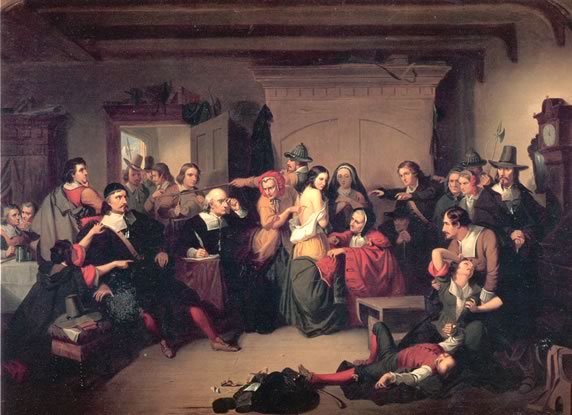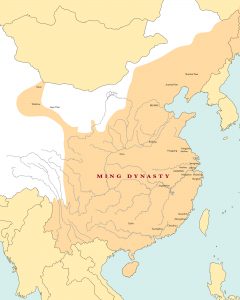Why would adults in Salem, Massachusetts in the 1690s take the accusations of nine year old girls seriously? During the seventeenth century, New England had grown diverse. The people living in the communities were of different backgrounds. But in the 1690’s there was an apparent outbreak of witchcraft. The most famous of these outbreaks was the event in Salem, Massachusetts in 1692 that stirred up the Salem community and soon spread to other communities.
The widespread hysteria over witches was all over the town after an accusation of witchcraft was made in January 1692. A group of young adolescent girls met in the home of Samuel Parris, a Puritan pastor in Salem. The pastor had a nine year old daughter, Betty. Betty and her cousin Abigail were fascinated by the voodoo tales and tricks told to them by the family slave. The family slave, Tituba, was the one whom the little girls had sought after for entertainment.1 It was not long after their time spent with Tituba, when the girls began to behave strangely; seeing visions, babbling at times, and lapsing into trances. The Puritans thought that these behaviors were of witchcraft, as the work of the devil. People in Salem began believing the girls, and charged Tituba and two other village women for practicing witchcraft on them. Two men, John Hathorne and Johnathan Corwin of Massachusetts, were called to do a legal examination of the women. The Puritans followed the Old Testament law. This was how they assessed the examinations. Scripture had a statement that said witches were not able to live. The two men knew exactly what they had to do. The examination was done on these women of Salem by looking for a certain mark on the body: a wart or tit. This specific mark was said to be the place where the devil and his demons would take blood out of the witch.2 Many of the women accused were of lower status in the community.

Research shows most of the accused witches were middle-aged women, widowed, with few or no children. Also, if the woman had been involved with domestic conflicts, they were accused. The women were accused of crimes and appeared to be dangerous by their neighbors. Women in Salem who inherited or possessed land were also accused of witchcraft.3 The accusations towards these women were out of the ordinary and seemingly wrong. One must first think about the view of women during this time. They were undermined and portrayed as having no power or knowledge of such things; they were subservient to the men in the community. Not only were low class women accused of witchcraft, but as time passed, superior women were accused as well.4
On October 29th, the Salem Witch Trials were called to an end. Governor Phips dismissed the Court and that marked the end to the witch hunt craze. Many were disappointed about the ending of the trials, but many were glad to return to work.5 The community in Salem blamed Pastor Parris for letting the innocent die. The people of the Salem church also voted to void his salary. In the following years, those family members of the deceased were restored their good names. The families were awarded a compensation for all the financial loses they went through during such tragic times. Increase Mather, a pastor of the Boston Puritan Church, wanted the people to do away with the court because he believed they put innocent people to death.
The Witch trials took on an important role in American History. The trials became a tragic and memorable moment in history. Generational, racial, and sexual hostility, opposition to law, social stresses, and food poisoning were all causes as to why the people had anxieties that found release in the witch hunt craze. The witch hunts became searches for scapegoats; the community leaders were looking for anyway possible to ease the community’s anxieties.6
- Kenneth P. Minkema, “In the Devil’s Snare: The Salem Witchcraft Crisis of 1692,” The Christian Century, no. 8 (2003): 37. ↵
- Salem Press Encyclopedia, January 2015, s.v. “Salem Witchcraft Trials,” by Warren M. Billings and Kimberly Manning. ↵
- Alan Brinkley, American History, 15th ed., vol. 1: to 1865 (2 Penn Plaza, New York, NY 10121: McGraw Hill Education, 2015), 86-87. ↵
- Salem Press Encyclopedia, January 2015 s.v. “Salem Witchcraft Trials,” by Warren M. Billings, Kimberly Manning. ↵
- Salem Press Encyclopedia, January 2015 s.v. “Salem Witchcraft Trials,” by Warren M. Billings, Kimberly Manning. ↵
- Salem Press Encyclopedia, January 2015 s.v. “Salem Witchcraft Trials,” by Warren M. Billings and Kimberly Manning. ↵



178 comments
Eliana Villarreal
I have no prior knowledge of the Salem Witch Trials but this article gave really good insight on what this period in time was generally all about! It is unfortunate that innocent lower class women were being accused of such activities and were also killed. The little to no education they had left them defenseless. Even if the families of these women were later financially compensated, it does not bring back the life of their loved ones.
Mariah Podwika
I really enjoyed this article; as someone who really enjoys reading about the Salem Witch Trials and is fascinated by its history, this was an excellent article that covers how it all began. The fact that the beginning of something as big as the trials was something as small as a girl and her friends liking some voodoo stories is a crazy thing to think about. There is no shortage of romanticism surrounding witches and witchcraft in current media circles. Every day, it seems like some new book, movie, or tv show is coming out that involves witches. But it was not always like that. Witches weren’t always seen as light-hearted fun that could be used as yard decor around Halloween time. Hundreds of people, if not more, lost their lives to this absurd witchhunt (for lack of a better term.) It is unbelievable that people could find just about any reason to throw someone under the bus and get them burned at the stake. It speaks volumes about what kinds of evidence that were needed for something to be deemed “believable.”
Aidan Farrell
This is a very intriguing article. I did not know a lot about the Salem Witch Trials, especially how it was started, but this article helped me learn a lot about that frankly barbaric time period. I think you did a good splitting the information up into paragraphs, and putting the right information in the right places. If I had to say anything, it’s that the article is rather short. Otherwise, well done.
Amelie Rivas-Berlanga
The Salem witch trials were an extremely important event in history. It highlighted the fear that people had to live with daily. The story of Tituba and the others was very much a real thing that happened. Imagine someone not liking you and they could just accuse you of witchcraft and you get killed in the more brutal ways. This article was extremely well organized, and highlighted the reason people accused people, and how people paid for these consequences.
SANTIAGO SABOGAL
This article written by Oscar Sepulveda tells us about uno of the most horrendous chapters of the colonies in the U.S, the indiscriminate persecution of “witches” in Salem ending the 17th century. This reading lets us see how it was back then and how women were misplaced and mistreated in the puritans society. Women were in danger and had no guarantees, since any man that just disliked her or wanted to kill her, all he had to do was to acusate her from witchcraft and with no hesitation, they would burn her alive. This tragic chapter led to hundreds of deaths, most of the women were low and middle class, but still sometimes rich women would also be burned.
Seth Roen
It’s hard to believe what people would consider for not only justice, either for men or the divine. What surprises me the most is how fear could quickly spread in communities both near and far. It’s sad how many people had to die because of the fear of a few. What’s even more painful is that events like this still happen, in one form or another.
Caily Torres
I have always been confused as to why women were the target of such a horrific event. In that time period women were under the control of men and had little education, so it confuses me as to how they would know of practices such as witch craft. I understand that knowledge can be passed down from ancestors but I agree with the author of this article that they just used this as an excuse to relieve the town of its underlying issues.
Soleil Armijo
I have always found the motives for the Salem Witch Trails sad and disturbing! This article does an effective job of giving information regarding the trials. I always ask myself how people could have been so naive to think that witches were women of such specific criteria, but the motives were highly sexist and bias.
Madeline Chandler
Such an informative and interesting article! Very captivating. Honestly I am familiar with the Salem Witch trials, like many other. However I did not know thing about him in this detail. This time in American history reflected darkness, death, persecution, and sexism to the fullest. This was such a transition for the United States in regard to following religious leads or justice. I loved reading your article. Great job
Nathan Castillo
I actually really like reading about the Salem Witch trials. The history always fascinates me and how people back then took their religion and faith into a whole other level. I do remember reading the play “The Crucible” and I am currently reflecting on how everyone, especially women, were falsely accused due to some family tensions, arguments, and over all racial views of other people.